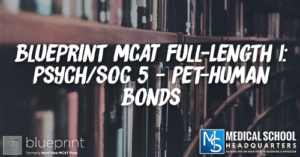You still have time to sign up with one of our amazing expert advisors! Learn More!

This week, we hit another passage. This passage is all about companion animals and their emotional ties to others. Listen now as we break everything down!
We’re joined by Dorothy from Blueprint MCAT. If you would like to follow along on YouTube, go to premed.tv.
Listen to this podcast episode with the player above, or keep reading for the highlights and takeaway points.
The MCAT will give you harder passages and they’ll also give you some easier ones as well. Be okay with that. As long as you are confident about knowing those definitions, and how they apply in certain situations, you have no reason to second guess yourself. And so, have some confidence in yourself.
You’ve put in all the work by test day to get to that point. Trust yourself and try not to second guess because that’s when things get a little slippery.
Additionally, know that there are test questions on the actual exam that will give you a little bit of potential emotional buffer. At the end of the day, you want to leave the exam feeling like you put in your best guesses, or at least, your most educated guesses on every single question. So as long as you do that, cleanse your palate, move on.
'Don't let your past performance or performance on past passages affect the way that you perform, moving forward.'Click To TweetCompanion animals have been part of the human experience for millennia. Many pet owners report having very strong social bonds with their animals and view them as members of the family. Research suggests that pet ownership can provide health benefits by reducing stress and improving exercise habits. Ownership is also thought to enhance mental well-being through mechanisms such as increased perceived social support, strong emotional attachment, and subjective experiences of happiness. While this “pro-pet” evidence is robust, little is known about the physiological or neural substrates that underlie these relationships.
Notes:
We can highlight “companion animals” because that seems to be the overarching subject here. And we’re essentially talking about how animals can impact human experiences in terms of well being, social funds and things like that. Other key terms we could highlight are also highlighted above.
An experiment was conducted to investigate the possible physiological mechanisms of human-pet relationships. Researchers theorized that interaction with pets should increase positive affect, which results in activation of brain areas associated with reward and pleasure, as well as effecting changes in plasma hormone concentrations. Twenty pet owners were recruited to participate in a series of pet-related tasks. The first step was completing a questionnaire about their pets (outlined in Table 1). Next, participants were shown images of their pets while undergoing fMRI scans; recent research suggests that the left side of the brain is in charge of processing positive emotion, so the anatomical location and size of the areas that showed relevant activation patterns were recorded (see Table 2). Finally, mean arterial blood pressure and blood samples were collected before and after participants spent 20 minutes with their pets in the observation room (see Table 3).
Notes:
This paragraph is talking about methods that were used in this particular experiment. So first off, ask what this experiment is testing. And in that first sentence there, we see, this experiment is investigating the possible physiological mechanisms of those human pet relationships.
Then we can look at the different methods that were used. They were looking at activation of brain areas associated with reward and pleasure. They were also looking at plasma hormone concentrations.
Unless it’s something like PCR or something that’s really foundational, usually, they won’t ask too many in-depth questions about the methods themselves. And they’d be more focused on results and interpreting figures as well as looking at background information.
Also note that they did a questionnaire. They also did some fMRI looking at brain anatomy. And then they also looked at the mean arterial blood pressure and those blood samples for presumably hormone processing.
Table 1 Participant characteristics
Notes:
Looking at table one, we see participant characteristics and then we see a frequency of certain things and some stats here. 55% of our participants are female, so we assume 45% are male.
We’ve got an average age and average time of pet and a breakdown of pet ownership. And whether they’re dogs or cats or guinea pigs, almost all of these participants noted a pretty strong connection with their pet (93.4%), and indicated that their pet was a source of social support (95.7%).
Table 2 fMRI brain activation patterns while viewing pet images
Notes:
This is where we’re talking about brain anatomy and what parts of the brain are activated. Based on Paragraph 2, it says that the left side of the brain is in charge of processing positive emotion. So it makes sense that a lot of these fMRI scans are done in the left hemisphere here. You’ve got the amygdala which plays a role in processing emotional information.
Noting that we’re working primarily in the left hemisphere, but we do also have the right hemisphere for the substantia nigra and ventral tegmental area there.
Then we have the Activation Area. We can assume that a larger number here means higher activation levels.
Table 3 Measured changes following pet interaction
*p < 0.01
Notes:
Table 3 shows measured changes following pet interaction, and you have a before and after. Also, notice the asterisk, which says that p is less than 0.01. So that is our statistical significance. And when an asterisk is provided, that means it’s a statistically significant difference.
Which of the following is NOT a core component of emotion?
Thought Process:
“Conditioned responses” is the outlier here. There’s like the ABCs of emotion. You’ve got your physiological arousal. You’ve got a behavioral component and then a cognitive component as well. So it’s like a body-mind-action kind of thing. And answer choices A, C and D all fall under the core components. Whereas for conditioned responses, think about operant conditioning or classical conditioning where you are pairing a stimulus to an actual behavior.
Correct Answer: B
The results of the study support which of the following conclusions?
Thought Process:
We have a straightforward answer, which is B. But Dorothy says that D seems to be the most tempting answer for most students. But the evidence to support this particular idea that we could have a potential treatment is just a step too far.
Correct Answer: B
'If you read the passage well and thoroughly and use your highlighter to your advantage to really process the information that's there, you can actually get really far.'Click To TweetThe information in Table 2 provides support for which of the following concepts?
Thought Process:
The answer here is D where you get lateralization of that positive emotion. We’re told from the passage that left-sided activation correlates more strongly to positive emotions. So kind of combining that information with what you see in the table where there’s really high numbers on the left side leaves with you to D.
Correct Answer: D
Which of the following statements about human-pet interactions best reflects the Schachter-Singer theory of emotion?
Thought Process:
You would have to know Schachter-Singer theory of emotion so that you can apply it here. We talked about these three components of emotion: arousal, our behavior and our cognitive components.
And essentially, what order do they go in? How do they occur in order to produce an emotion as a result? Schachter-Singer is all about cognitive interpretation and appraisal.
A – it’s a physiological response, which is the physical arousal part. Then you have some level of cognitive interpretation, where you’re interpreting the context. Your brain is thinking about what’s happening, and going to then produce an emotional experience as a result. And so A is all about this cognitive interpretation.
B – This is James Lange theory of emotion, where we have behavior and a physiological action leading to emotion. These two things happen independently, and then lead to emotion as a result. Here, the stimulus happens when Timothy’s dog runs out of the house. And then you get a physiological response where Timothy’s heart rate increases. And he also has a behavioral component. So he shouts for the dog to come home. And then those two things together will then help Timothy interpret his emotions before he actually starts to feel scared.
C – This is Cannon-Bard’s theory of emotion which is where physiological and cognitive things happen independently, but simultaneously. So we have Annabel holding her guinea pig and scratching its ear. Spending time with her pet is the stimulus. It leads to that physiological response of hormone release, but at the same time, she also interprets the situation as happy and calm. So those two things happen together – the physiological and the cognitive interpretation. And then we see the behavioral expression where she actually smiles.
Dorothy says this is a problem area for a lot of students where they find it hard to tell the differences between all these definitions. And she recommends separating the definitions for each one and looking at examples of each so it can become a lot clearer to distinguish.
Correct Answer: A

Lorem ipsum dolor sit amet, consectetur adipiscing elit
I just received my admission to XXXXX! This is unreal and almost feels like I am dreaming. I want to thank you for all of your help with my application. I cannot overstate how influential your guidance and insight have been with this result and I am eternally grateful for your support!
IM SO HAPPY!!!! THANK YOU SO MUCH FOR ALL YOUR HELP, IM INDEBTED TO YOU! Truly, thank you so much for all your help. Thank you doesnt do enough.
I want to take a few moments and thank you for all of your very instructive, kind and consistent feedback and support through my applications and it is your wishes, feedback, and most importantly your blessings that have landed me the acceptance!
I got into XXXXX this morning!!!! It still has not hit me that I will be a doctor now!! Thank you for all your help, your words and motivation have brought me to this point.
I wanted to once again express my heartfelt gratitude for your help in providing feedback during my secondary applications. Your guidance has been instrumental in my journey.
Just wanted to share my wonderful news! I received my first medical school acceptance! Thank you for all that you do for us Application Academy!!!
I am excited to tell you that I just got my third interview invite from XXXXX today! I can’t believe it. I didn’t even know if I was good enough to get one, let alone three – by mid-September. Thank you so much for all of your help and support up to this point; I would not be in this position without it!!
I wanted to thank you for helping me prepare for my XXXXX interview. Even in a 30-minute advising session, I learned so much from you. Thank you for believing in me, and here’s to another potential success story from one of your advisees!
I just received an acceptance with XXXXX! This is so exciting and such a huge relief and so nice to have one of our top choice schools! I also received an interview with XXXXX which brings the total up to 20 interviews! Thank so much, none of this would have been possible without you!

Join our newsletter to stay up to date
* By subscribing you agree to with our Privacy Policy and provide consent to receive updates from our company.
Resources
Advising Services
Podcasts & Youtube
Books
About
Deal Lasts for

"*" indicates required fields